Introduction to Oyster Stew Recipe
The Historical Roots of Oyster Stew
Oyster stew recipe, a quintessential dish renowned for its rich, creamy texture and deep flavors, has long held a place at American dining tables. Traditionally linked with holiday celebrations, particularly Christmas Eve, the stew has a storied history that reflects both culinary tradition and regional flavor. Its roots can be traced back to the early settlements along the Atlantic coast where oysters were plentiful and stewing was a common cooking method.
Cultural Significance and Regional Variations
- Popularity Across Regions: The popularity of oyster stew is not confined to any one area, but it is especially beloved in the Northeast and Gulf Coast regions, where seafood plays a pivotal role in local cuisine.
- Holiday Traditions: In many families, the preparation of oyster stew is a cherished holiday ritual, passed down through generations.
Over the ages, this soothing stew has evolved, with distinctive regional variations enriching the foundational formula. In New England, for instance, oyster stew is often enriched with salt pork and aromatic vegetables, while Southern versions might include a dash of hot sauce or spices to enhance the warmth and complexity of the dish. For a deeper look into the evolution of this beloved dish, consider exploring more about the history of oyster stew.
Contemporary Enjoyment and Adaptations
Today, oyster stew continues to be a versatile and adaptable dish, reflecting both traditional methods and modern twists. Chefs and home cooks alike revel in adding personal touches to the stew, such as using local oyster varieties or experimenting with different cream bases. The dish’s versatility not only preserves its pertinence but also makes it suitable for diverse nutritional needs. To discover how current trends influence traditional dishes, check out tips for perfect seafood dishes.
Oyster stew remains a beloved staple in many culinary traditions, embodying a rich blend of history, culture, and regional tastes. Its persistent appeal guarantees its status as an emblem of warmth and festivity in numerous households.
Basic Recipe for Oyster Stew Recipe
Print
Classic Oyster Stew
- Total Time: 35 minutes
- Yield: Serves 4
- Diet: Gluten Free
Description
A velvety blend of tender oysters and aromatic vegetables, enveloped in a creamy base, makes this classic oyster stew a favorite during the holiday season and beyond. It’s a simple yet satisfying dish that brings the essence of the ocean to your dining table.
Ingredients
- ½ cup butter
- 1 cup minced celery
- 3 tablespoons minced shallots
- 1 quart half-and-half cream
- 2 (12 ounce) containers fresh shucked oysters, undrained
- 1 pinch cayenne pepper, or to taste
- Salt and ground black pepper to taste
Instructions
- Melt the butter in a large pot over medium heat. Add the celery and shallots, and sauté until soft.
- Pour in the half-and-half and gently simmer, avoiding a boil to prevent curdling.
- Add the oysters with their liquor, season with cayenne, salt, and black pepper. Cook until the oysters are just firm, about 6-8 minutes.
Notes
- For a lighter version, substitute half-and-half with whole milk or a mixture of milk and cream.
- Enhance the stew with fresh herbs like parsley or chives before serving.
- Prep Time: 15 minutes
- Cook Time: 20 minutes
- Category: Main Dish
- Method: Stewing
- Cuisine: American
Nutrition
- Serving Size: Approximately 1 cup
- Calories: 250
- Sugar: 4g
- Sodium: 300mg
- Fat: 18g
- Saturated Fat: 10g
- Unsaturated Fat: 7g
- Trans Fat: 0g
- Carbohydrates: 10g
- Fiber: 1g
- Protein: 10g
- Cholesterol: 75mg
Keywords: Oyster Stew
For those interested in exploring additional innovative oyster recipes, consider visiting this food blog.
STEPS
Step 1: Gather all ingredients.
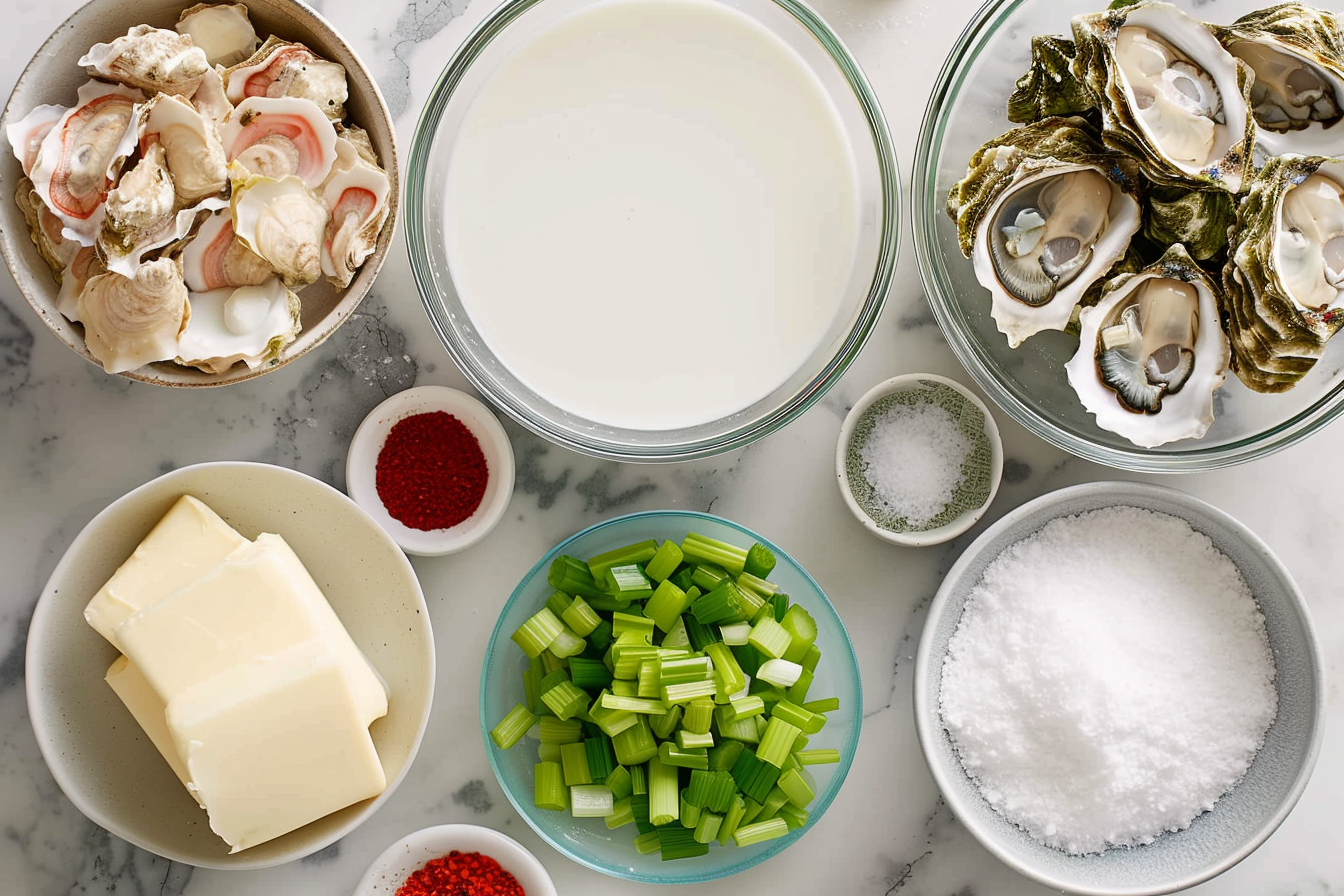
Step 2: In a spacious skillet set over medium heat, melt the butter. Incorporate celery and shallots; sauté until the shallots become soft, about 3 to 5 minutes.
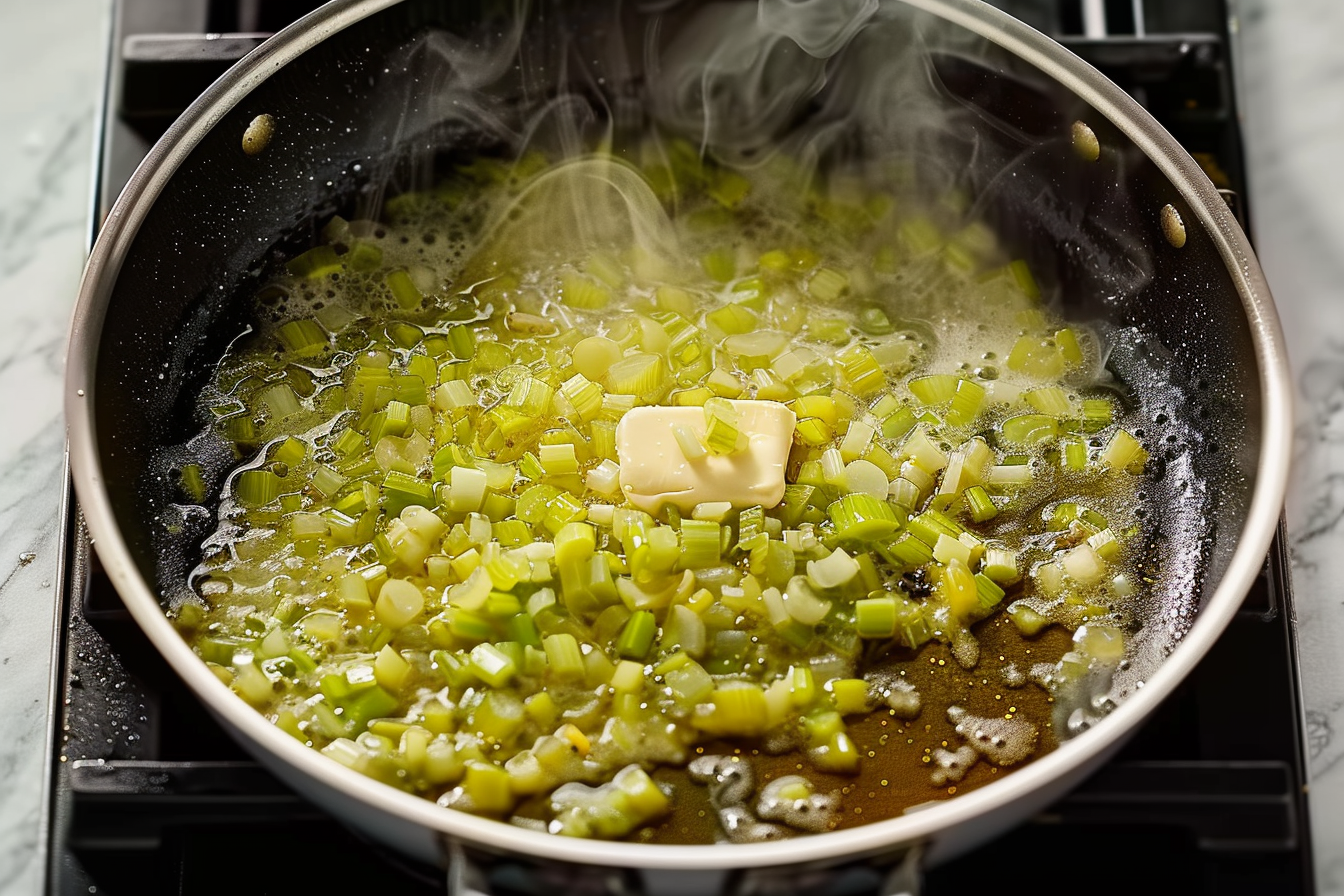
Step 3: Warm the half-and-half in a sizable pot on medium-high heat. Incorporate the mixture of celery and shallots, stirring constantly until it’s nearly boiling. Then, add the oysters along with their liquid, and season with cayenne pepper, salt, and black pepper.

Step 4: Continue cooking and stirring until the oysters begin to curl at the edges. Once this occurs, turn off the heat and serve right away.
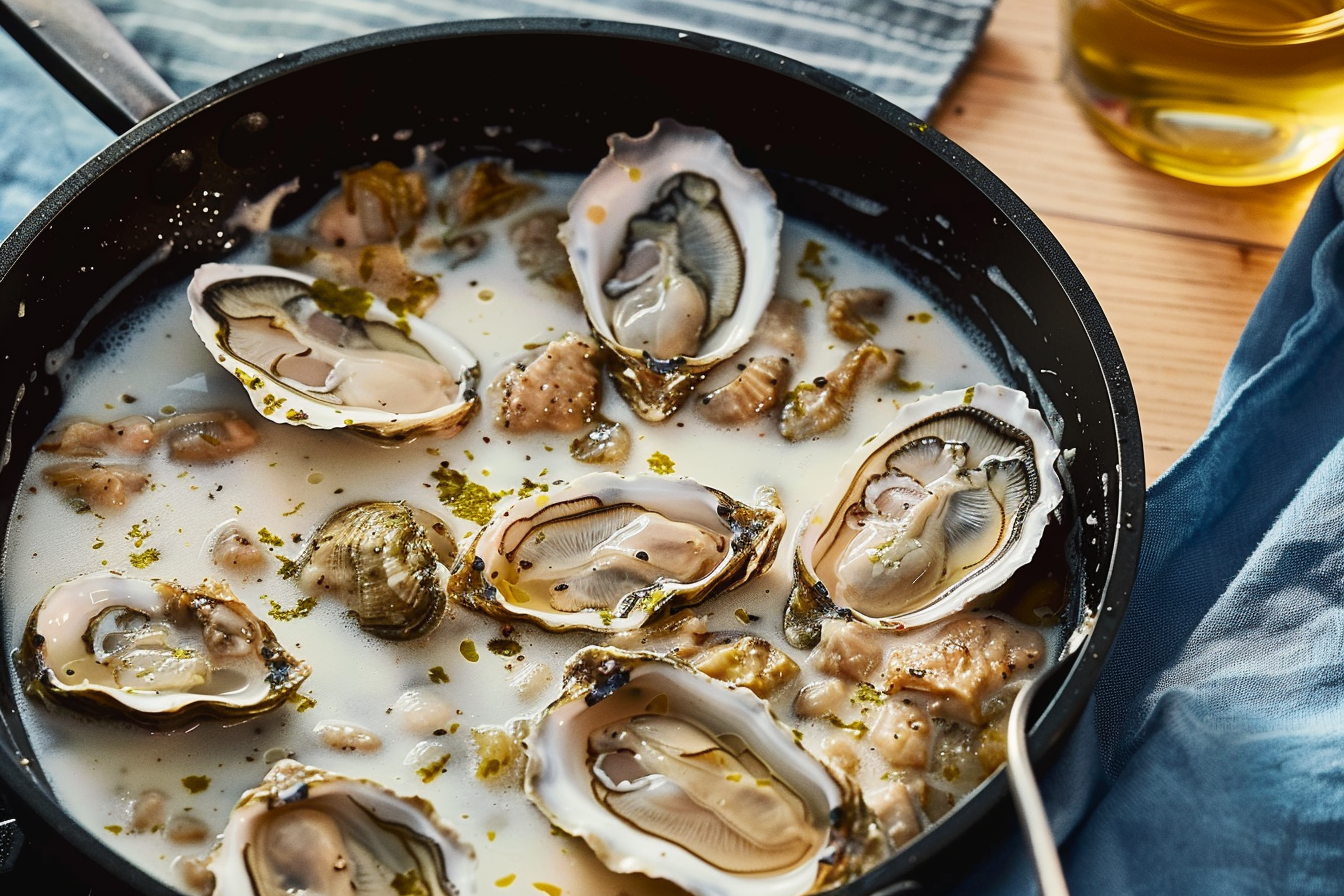
Advanced Cooking Techniques for Oyster Stew Recipe
Selecting the Best Oysters
Choosing the right oysters is crucial for creating an exceptional oyster stew. Prioritize freshness—select oysters that are firmly closed and carry a fresh ocean scent. Opt for the freshest oysters to enhance the taste and consistency of your stew.
- Freshness Check: Ensure the shells are closed; this indicates the oysters are alive.
- Sourcing: Opt for oysters from reputable sources known for sustainable harvesting.
Enhancing Flavor Through Pre-Cooking Techniques
Before adding your oysters to the stew, consider pre-cooking them to enhance their flavor. Roasting or broiling oysters can add a depth of flavor that raw oysters cannot match.
- Roasting: Lightly roast oysters in their shells in a preheated oven to bring out a richer, more caramelized flavor.
- Broiling: Broil oysters with a dab of butter and herbs to infuse them with additional flavors before adding them to the stew.
Optimizing Cooking Temperatures and Times
To ensure that your oyster stew is both delicious and safe to eat, pay close attention to the cooking temperatures and times. Oysters should be cooked just enough to firm up, but overcooking can make them rubbery and tough.
- Maintain a mild simmer: To prevent the cream from curdling and to cook the oysters flawlessly, keep the stew gently simmering.
- Timing Is Key: Cook the oysters in the stew for no more than 6-8 minutes to maintain their delicate texture.
By incorporating these advanced techniques into your oyster stew preparation, you elevate the dish from simple to sublime, ensuring that every spoonful is a celebration of the sea. Whether you’re a seasoned chef or a home cook, these tips can help you enhance your culinary skills and impress your guests with a luxurious and flavorful oyster stew. Didcover more advanced recipes

Maintenance and Storage Tips for Oyster Stew
Storing Leftover Stew
Proper storage is essential to maintain the quality and safety of your oyster stew. Cool the stew quickly and refrigerate it within two hours of cooking. Store the stew in sealed containers to maintain freshness and avoid picking up odors from other items in the refrigerator.
- Rapid Cooling: Spread the stew in a shallow dish to cool it faster before refrigerating.
- Refrigeration: Store the stew in the refrigerator for up to two days to maintain its best quality.
Reheating Oyster Stew
When reheating oyster stew, gentle heat is key to preserving the texture and flavor of the oysters. Reheat on the stove over low heat until just hot enough to serve, stirring occasionally to prevent the bottom from sticking or burning.
- Avoid Boiling: Never bring the stew to a boil during reheating to prevent the oysters from becoming tough and chewy.
- Consistent Heating: Ensure the stew reaches an even temperature throughout before serving.
Freezing Tips
Freezing oyster stew can affect the texture of the cream and oysters, but it can be done if you plan to use the thawed stew in a cooked dish. If freezing, it’s best to do so without the dairy, adding fresh cream upon reheating.
- Preparation for Freezing: Freeze the stew base without dairy, and add fresh cream or half-and-half when reheating.
- Thawing Guidelines: Allow the stew to defrost in the refrigerator overnight and then reheat it gently on the stove.
Adhering to these suggestions will prolong the shelf life of your oyster stew, allowing you to relish its delightful taste well after the first serving. Proper maintenance not only ensures safety but also preserves the delicate flavors that make this dish a beloved comfort food.
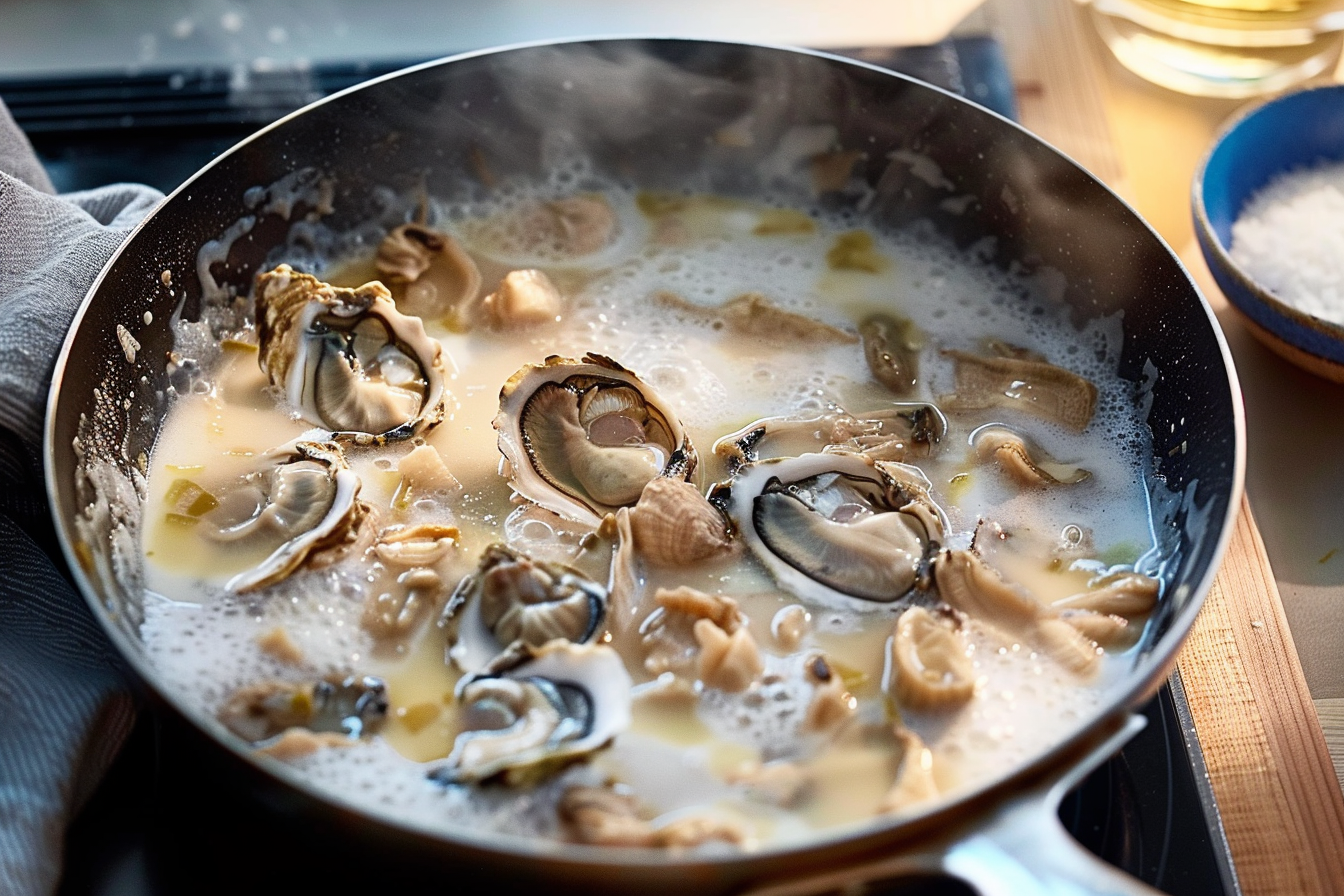
Dietary Adaptations for Oyster Stew Recipe
Gluten-Free and Low-Fat Variations
Adapting your oyster stew to accommodate dietary restrictions doesn’t mean sacrificing flavor. To make a gluten-free variant, verify that all components, such as thickeners, do not contain gluten. To reduce the fat content, substitute the half-and-half with a mixture of skim milk and a gluten-free thickening agent like cornstarch.
- Gluten-Free Thickeners: Use cornstarch or a gluten-free flour blend to thicken the stew without gluten.
- Low-Fat Dairy Options: Opt for low-fat or fat-free milk to significantly reduce the fat content while maintaining creaminess.
Vegan and Vegetarian Alternatives
Creating a vegan version of the classic oyster stew involves substituting the oysters and dairy with plant-based alternatives. Mushrooms or jackfruit can mimic the texture and umami of oysters, while coconut milk offers a rich, creamy base without the dairy.
- Mushrooms as a Substitute: Use finely chopped mushrooms to replicate the texture and flavor depth of oysters.
- Coconut Milk Creaminess: Substitute half-and-half with coconut milk for a rich, vegan-friendly base.
Keto-Friendly Adaptations
For those following a ketogenic diet, adapting oyster stew recipe to fit into a low-carb lifestyle is straightforward. Substitute the half-and-half with full-fat coconut milk or heavy cream, making sure that all additional ingredients are low in carbs.
- High-Fat Replacements: Use heavy cream to maintain richness without adding carbs.
- Watching the Carbs: Be mindful of the carbohydrate content in all ingredients used in the stew.
These modifications cater to those with particular dietary requirements or preferences, enabling them to savor the deep, comforting tastes of oyster stew. With these modifications, the stew can remain a satisfying and inclusive dish that continues to be cherished across diverse dietary landscapes.
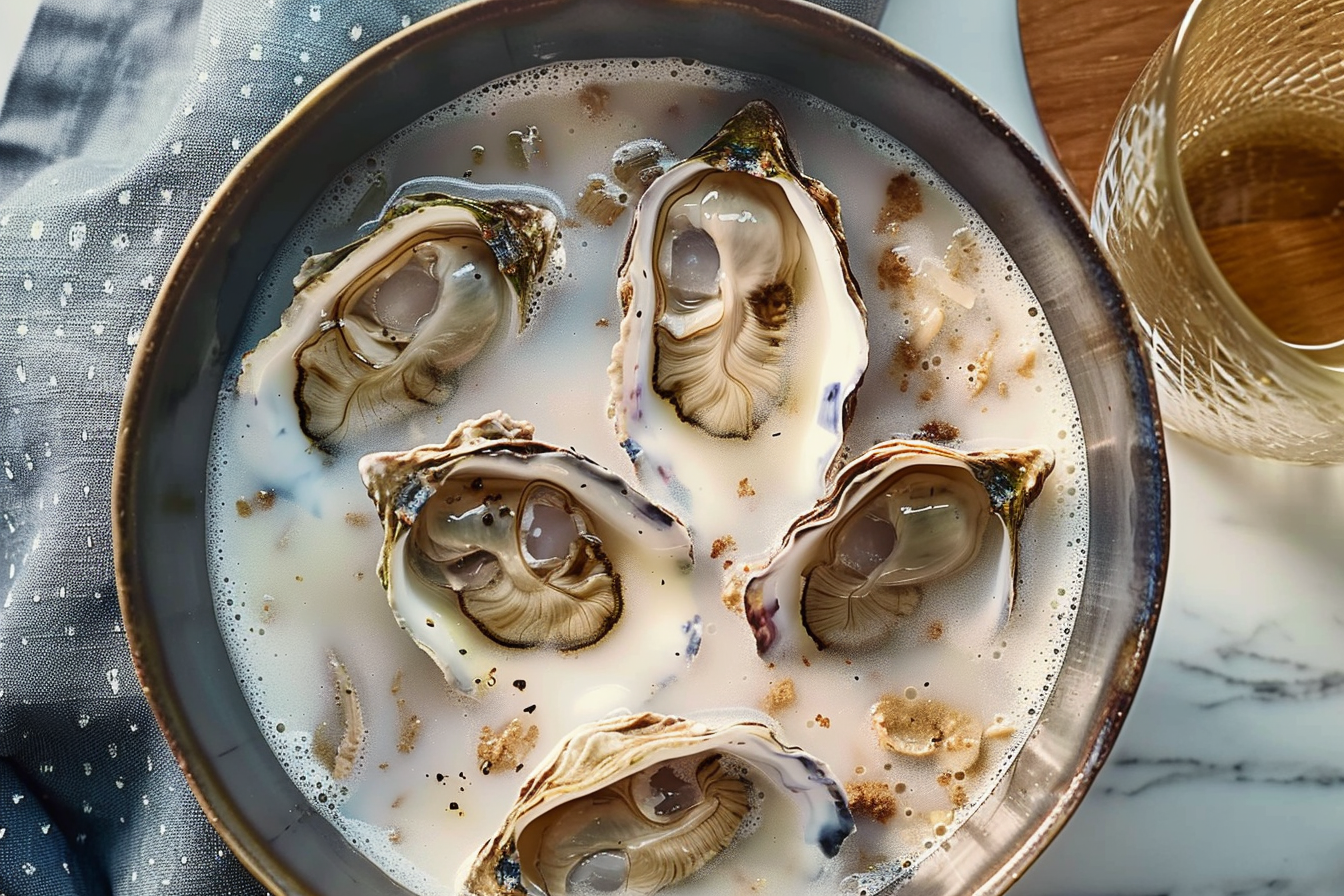
Frequently Asked Questions (FAQs) About Oyster Stew
Can Oyster Stew Be Frozen?
While you can freeze oyster stew recipe, it’s crucial to consider the changes in texture that may occur, especially with the dairy components and the oysters themselves. For best results, freeze the stew without the dairy and add fresh cream when reheating.
- Texture Considerations: Expect some changes in texture, particularly if the stew contains dairy.
- Freezing Methods: Store individual portions in sealed containers or robust freezer bags.
How Do You Know When Oysters Are Cooked in the Stew?
Oysters in your oyster stew should be cooked until they are firm and the edges curl slightly. This typically takes about 6-8 minutes in simmering liquid.
- Visual Cues: Look for oysters that have started to curl at the edges; this indicates they are cooked.
- Timing: Avoid overcooking to prevent the oysters from becoming rubbery.
Which Oysters Are Ideal for Making Stew?
The best oysters for oyster stew are fresh, plump, and have a clean, briny flavor. Varieties such as Eastern oysters or Pacific oysters are excellent choices due to their flavor profiles and meaty textures.
- Oyster Varieties: Choose based on available fresh options and personal flavor preference.
- Freshness: Always opt for the freshest oysters from reputable suppliers.
Addressing these common inquiries helps both novice and experienced cooks master the art of making oyster stew, ensuring delightful results that capture the essence of this cherished dish. By understanding these aspects, you can enhance your cooking experience and enjoy a delicious stew that brings comfort and flavor to any meal.

Additional Resources and References for Oyster Stew
Exploring Video Tutorials
For those who prefer a visual guide to reading through recipes, several video tutorials available online offer step-by-step instructions on making oyster stew. These videos can provide helpful tips and techniques that might not be as clear in written recipes.
- Visual Learning: Watching the preparation can clarify the process, from chopping ingredients to the final simmer.
- Engagement: Engage with creators by asking questions or discussing variations in the comment sections of these videos.
Deepening Knowledge with Articles
Reading articles about the nutritional benefits and historical context of oyster stew can enhance your understanding and appreciation of this dish. These articles often delve into the cultural significance of oyster stew across different regions.
- Nutritional Overview: Explore the nutritional advantages of core components such as oysters, known for their abundance of vital nutrients.
- Cultural Perspectives: Explore how oyster stew fits into various culinary traditions and how it has evolved over time.
Connecting with Food Blogs
Food blogs are a treasure trove of creative recipes and personal anecdotes related to oyster stew. Bloggers often share their unique twists on traditional recipes, providing inspiration for you to experiment with new flavors and ingredients.
- Recipe Variations: Discover new and innovative ways to adapt oyster stew to suit contemporary tastes or dietary requirements.
- Community Interaction: Participate in discussions with fellow food enthusiasts who share a passion for seafood dishes.
Utilizing these resources can significantly enrich your cooking experience, providing you with a broader range of ideas and skills to bring to your kitchen endeavors. Whether you aim to refine your oyster stew or simply enhance it with some creativity, these tools are indispensable for any cooking aficionado.
